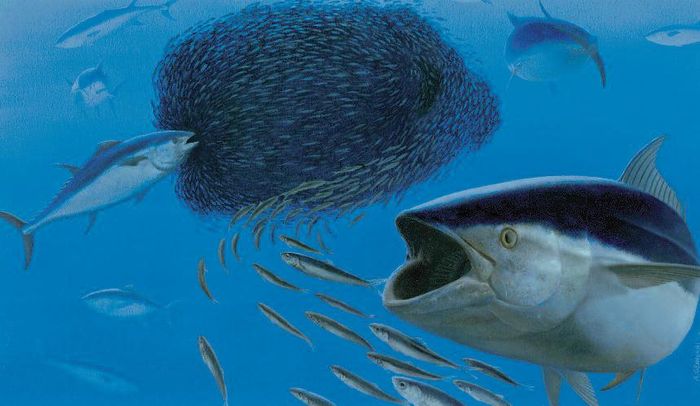MarBEF examples of fishery effects
Contents
Effects on ecosystem structure and functioning
Fishing affects fish populations in many ways. Many fish populations have been reduced to low numbers due to long-term impacts of fishing (e.g., cod in Baltic Sea) and some populations may be approaching collapses (e.g., bluefin tuna in the North East Atlantic and the Mediterranean Sea).[1]
Fishing and fish collapses
Historical studies have shown that cod in the eastern Baltic Sea were more abundant 400 years ago than in the late 20th century. This result is surprising, because the Baltic Sea was not very “cod-friendly” 400 years ago: It was much less productive than today (i.e., before the increase in nutrients and primary production of the 20th century) and marine mammal predators of cod (seals) were more abundant. The higher abundance of cod in the 1500s was probably related to the overall lower level of exploitation in the 1500s.
Bluefin tuna were abundant in northern European waters such as the North and Norwegian Seas until the late 1960s and the early 1970s, when they disappeared; they have not yet returned. The reasons for their disappearance are not clear. However, since the 1970s, the overall biomass in the entire North East Atlantic and Mediterranean has declined and landings have been too high for too many years to allow recovery. Legitimate fishing quotas are exceeded by illegal landings and catches of undersized fish. As a result, the population is at risk of collapse and has been disappearing from other areas of its range including the Black Sea and parts of the Mediterranean[1].
Predator-prey interactions
Heavy exploitation of a fish population can also have consequences for other species in the ecosystem. These consequences include effects on abundances of prey species, and how predators and prey interact (e.g., the structure and functioning of ecosystems). It can cause “cascading” effects in which abundances of prey species increase in response to decreases in abundances of predators. The increase in the prey species then has an effect the next trophic level (its food), and so on.
An early example of this ecological cascade occurred in Denmark, in the early 1800s, when heavy fishing pressure contributed to the collapse of a local herring population. This caused a dominance of jellyfish including Aurelia aurita. The ecosystem became so dominated by jellyfish that fishermen were complaining that they could not haul their nets. This example seems to have been repeated in other areas around the world where fishing has removed large quantities of zooplanktivorous fish, such as herring, sardines or anchovy, and jellyfish subsequently became abundant[1].
Evolutionary effects of fisheries
Fishing is by nature a selective process: some individuals are more likely to avoid capture, survive and reproduce than others due to individual differences in size, morphology or behaviour. Fishing may therefore act selectively on reproductive age- and size-groups. If these differences are heritable, then fishing will have evolutionary effects on the population over time. In addition, different populations of the same species may be more sensitive to exploitation. This could lead to a decline of certain populations while other populations of the same species are less affected.
One effect which has been demonstrated is that fishing causes phenotypic evolution. This effect, which favours evolution towards earlier maturation, has been observed in nature in several wild fish populations. These observations strongly suggest that fisheries-induced evolution towards earlier maturation at smaller size is commonplace. The pace of fisheries-induced evolution can be very high and has led to detectable changes over only a few generations. These findings of evolutionary effects of fishing are controversial and still being debated in the scientific literature.
However, whether the observed change is genetic or otherwise, the phenotypic diversity of fishes is declining. As a consequence, fish populations may be becoming more vulnerable (and less resilient) to perturbations such as fishing, climate change and invasive alien species[1].
See Effects of fisheries on marine biodiversity.
References
- ↑ 1.0 1.1 1.2 1.3 Heip, C., Hummel, H., van Avesaath, P., Appeltans, W., Arvanitidis, C., Aspden, R., Austen, M., Boero, F., Bouma, TJ., Boxshall, G., Buchholz, F., Crowe, T., Delaney, A., Deprez, T., Emblow, C., Feral, JP., Gasol, JM., Gooday, A., Harder, J., Ianora, A., Kraberg, A., Mackenzie, B., Ojaveer, H., Paterson, D., Rumohr, H., Schiedek, D., Sokolowski, A., Somerfield, P., Sousa Pinto, I., Vincx, M., Węsławski, JM., Nash, R. (2009). Marine Biodiversity and Ecosystem Functioning. Printbase, Dublin, Ireland ISSN 2009-2539
